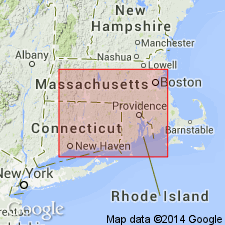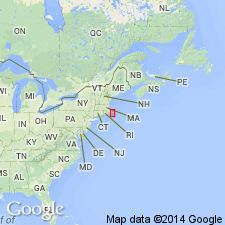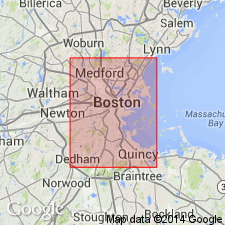
- Usage in publication:
-
- Marlboro Formation*
- Modifications:
-
- Age modified
- AAPG geologic province:
-
- New England province
Summary:
Age changed from Precambrian Z(?) to early Paleozoic to: Proterozoic Z, Cambrian, or Ordovician based on radiometric age determinations and stratigraphic relations [not clearly explained in text, but clearly shown with revised ages in correlation chart.]
Source: GNU records (USGS DDS-6; Reston GNULEX).

- Usage in publication:
-
- Marlboro Formation*
- Modifications:
-
- Overview
- AAPG geologic province:
-
- New England province
Summary:
Used as Marlboro Formation of Proterozoic Z, Cambrian, or Ordovician age. Subdivided into a homogenous gneiss unit and a unit of amphibolite, schist, gneiss, and granofels.
Source: GNU records (USGS DDS-6; Reston GNULEX).

- Usage in publication:
-
- Marlboro Formation*
- Modifications:
-
- Overview
- AAPG geologic province:
-
- New England province
Summary:
Marlboro Formation in Nashoba zone consists of interlayered metavolcanic and metavolcaniclastic rocks and marine metasedimentary rocks. Bell and Alvord (1976) divided it into an unnamed lower member of mica schist, calc-silicate rock, marble, and amphibolite, and the upper Sandy Pond Member (mostly amphibolite). Skehan and Abu-Moustafa (1976) divided it into 31 unnamed members (M1-M31) based on mapping in the Wachusett-Marlborough tunnel; most of the amphibolite is in lower part of the section, compared with Bell and Alvord's mapping. Hepburn and DiNitto (1978) and Hepburn (1978) recognized four divisions based on mapping of surface rocks above the tunnel in Marlborough and Shrewsbury area; one of their divisions is the [informal] Sandy Pond amphibolite member, which coincides with Bell and Alvord's Sandy Pond Member and with amphibolitic lower part (units M1-M16) of Skehan and Moustafa's section. It appears that all three amphibolites are equivalent. Marlboro also includes a lenticular mass of biotite granodioritic gneiss near Grafton that has inclusions of amphibolite and biotite schist of the Marlboro. Previously thought to be part of Milford Granite by Emerson (1917) and later informally named Grafton gneiss by H.R. Dixon (1977, written commun.). Although Castle (1965) considered Fish Brook to be either a premetamorphic intrusive rock or a core gneiss of intrusive or sedimentary ancestry, Bell and Alvord (1976) considered it to be volcanic or volcaniclastic in origin. Zircons in Fish Brook are certainly volcanic in origin and yield a date of 730 +/-26 Ma (Olszewski, 1980). If the rock were a core gneiss, that date would apply only to the Fish Brook and not to surrounding rocks; but, Bell and Alvord (1976) believe Fish Brook to be part of the Marlboro Formation-Nashoba Formation sequence and therefore the date does apply to the sequence. In addition, a 1500 Ma date for Shawsheen Gneiss [reference not given] helps bracket age of Marlboro-Nashoba sequence. An upper limit for the sequence was established from the 430 +/-5 Ma age of intruding Sharpers Pond Diorite and 450 +/-23 Ma age of the intruding Andover Granite (Zartman and Naylor, 1984). Although age on MA State bedrock map is shown as Proterozoic Z or Ordovician (due to uncertainty regarding actual rocks sampled by Olszewski and a strong belief that rocks of Nashoba zone correlated with Ordovician rocks to the west), author now feels that rocks of Nashoba zone (except for Tadmuck Brook Schist) are all Proterozoic, but that they are unlike the Proterozoic rocks of neighboring Milford-Dedham zone. [Chapters A-J in U.S. Geological Survey Professional Paper 1366 are intended as explanations and (or) revisions to 1:250,000-scale MA State bedrock geologic map of Zen and others (1983).]
Source: GNU records (USGS DDS-6; Reston GNULEX).

- Usage in publication:
-
- Marlboro Formation*
- Modifications:
-
- Areal extent
- Revised
- AAPG geologic province:
-
- New England province
Summary:
On bedrock geologic map of MA (Zen and others, 1983) some of the rocks of the metavolcanic assemblage (metamorphosed mafic and felsic flows, volcaniclastics, hypabyssal intrusive rocks, metamorphosed felsic rocks, and greenstone and amphibolite) were previously called Marlboro Formation by Emerson (1917). The name Marlboro is not now applicable east of Bloody Bluff fault. Metavolcanic assemblage rocks are intruded by Proterozoic Z granitoids and lie east of Lake Char-Bloody Bluff fault zone, whereas Marlboro Formation is intruded by Paleozoic granitoids and lies west of the fault zone. Report includes geologic maps and correlation charts. [Chapters A-J in U.S. Geological Survey Professional Paper 1366 are intended as explanations and (or) revisions to 1:250,000-scale MA State bedrock geologic map of Zen and others (1983).]
Source: GNU records (USGS DDS-6; Reston GNULEX).

- Usage in publication:
-
- Marlboro Formation
- Modifications:
-
- Age modified
- AAPG geologic province:
-
- New England province
Summary:
Fish Brook Gneiss of the Nashoba terrane has been dated by G.R. Dunning at 520+14-11 Ma. This not only establishes a Cambrian age for this unit, but constrains the age of the overlying Marlboro and Nashoba Formations to the interval between 520 Ma and 430 Ma, the age of the cross-cutting Sharpners Pond Diorite. No Precambrian rocks, therefore, are known from the Nashoba terrane.
Source: GNU records (USGS DDS-6; Reston GNULEX).
For more information, please contact Nancy Stamm, Geologic Names Committee Secretary.
Asterisk (*) indicates published by U.S. Geological Survey authors.
"No current usage" (†) implies that a name has been abandoned or has fallen into disuse. Former usage and, if known, replacement name given in parentheses ( ).
Slash (/) indicates name conflicts with nomenclatural guidelines (CSN, 1933; ACSN, 1961, 1970; NACSN, 1983, 2005, 2021). May be explained within brackets ([ ]).

